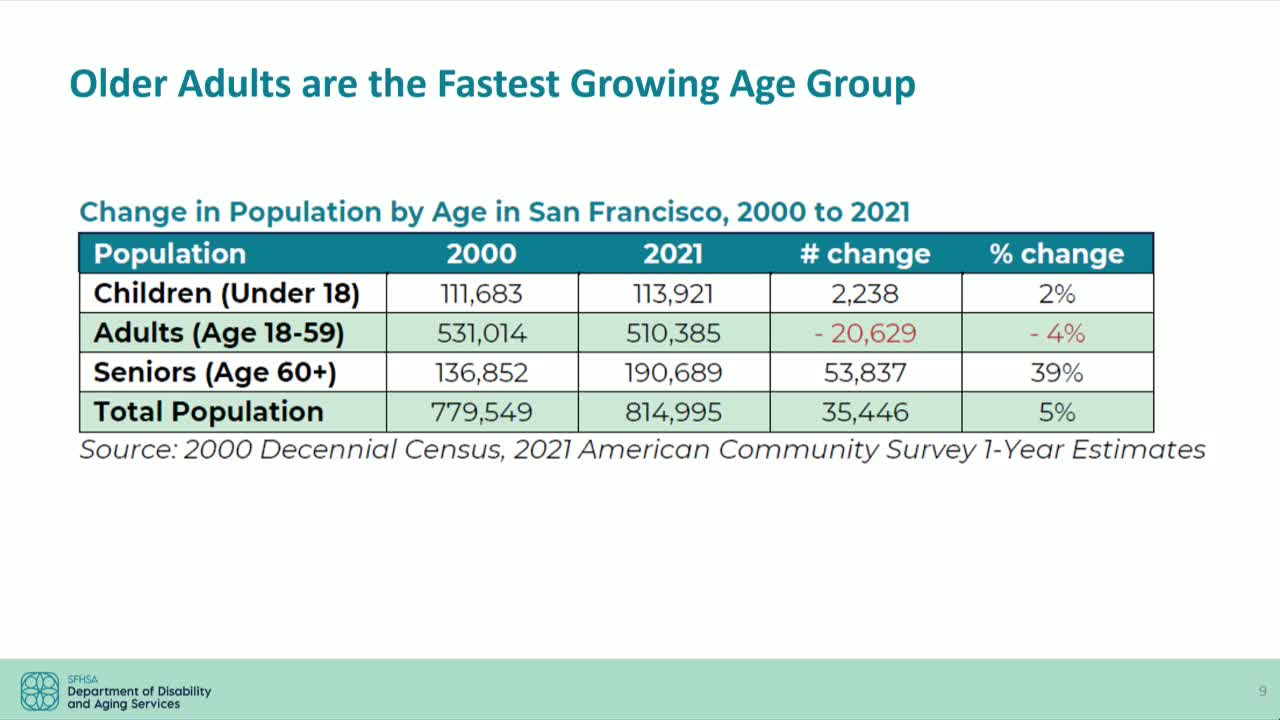San Francisco plans expand services for rapidly growing senior population by 2030
March 06, 2024 | San Francisco City, San Francisco County, California

This article was created by AI summarizing key points discussed. AI makes mistakes, so for full details and context, please refer to the video of the full meeting. Please report any errors so we can fix them. Report an error »

The recent government meeting in San Francisco focused on the significant demographic changes within the city, particularly the rapid growth of the older adult population. Officials highlighted that seniors are now the fastest-growing age group, with an increase of over 53,000 individuals since 2000, representing a 39% rise compared to a mere 5% growth in the overall population. Projections indicate that by 2030, individuals aged 60 and older will make up over 30% of the city's population.
The meeting underscored the challenges faced by older adults, particularly those living on fixed incomes. Approximately 13% of seniors, or over 25,000 individuals, live below the federal poverty level, a statistic that does not fully capture the financial strain due to San Francisco's high cost of living. Many senior renters are also rent-burdened, spending more than 30% of their income on housing, which limits their ability to afford basic necessities.
Diversity within the senior population was another key point, with a significant portion identifying as Asian Pacific Islander (44%) and white (37%). However, there has been a notable decline in the Black and African American senior population, which has decreased from 9% in 2000 to just 5% today. This trend raises concerns about displacement and the need for targeted support for communities of color, particularly among low-income seniors.
The meeting also addressed barriers to accessing services, particularly for older adults with disabilities. Findings from a recent needs assessment revealed that while basic needs are often met, issues related to social connectivity and mental health remain prevalent, exacerbated by the pandemic. The need for culturally responsive services for BIPOC and LGBTQ individuals was emphasized, as well as the necessity for improved resources for caregivers.
In response to these findings, the Department of Aging and Adult Services (DAS) outlined several priority populations for targeted support, including those at risk of social isolation and individuals with limited English proficiency. The department committed to allocating a minimum of 45% of its funding to access services, such as transportation and legal assistance, over the next four years.
The meeting concluded with a focus on future goals, including promoting inclusion for people with disabilities, enhancing workforce collaboration, and improving health and well-being for seniors. The establishment of a disability cultural center and expanded training for service providers were highlighted as key initiatives moving forward. Overall, the discussions underscored the urgent need for comprehensive strategies to address the evolving needs of San Francisco's aging population.
The meeting underscored the challenges faced by older adults, particularly those living on fixed incomes. Approximately 13% of seniors, or over 25,000 individuals, live below the federal poverty level, a statistic that does not fully capture the financial strain due to San Francisco's high cost of living. Many senior renters are also rent-burdened, spending more than 30% of their income on housing, which limits their ability to afford basic necessities.
Diversity within the senior population was another key point, with a significant portion identifying as Asian Pacific Islander (44%) and white (37%). However, there has been a notable decline in the Black and African American senior population, which has decreased from 9% in 2000 to just 5% today. This trend raises concerns about displacement and the need for targeted support for communities of color, particularly among low-income seniors.
The meeting also addressed barriers to accessing services, particularly for older adults with disabilities. Findings from a recent needs assessment revealed that while basic needs are often met, issues related to social connectivity and mental health remain prevalent, exacerbated by the pandemic. The need for culturally responsive services for BIPOC and LGBTQ individuals was emphasized, as well as the necessity for improved resources for caregivers.
In response to these findings, the Department of Aging and Adult Services (DAS) outlined several priority populations for targeted support, including those at risk of social isolation and individuals with limited English proficiency. The department committed to allocating a minimum of 45% of its funding to access services, such as transportation and legal assistance, over the next four years.
The meeting concluded with a focus on future goals, including promoting inclusion for people with disabilities, enhancing workforce collaboration, and improving health and well-being for seniors. The establishment of a disability cultural center and expanded training for service providers were highlighted as key initiatives moving forward. Overall, the discussions underscored the urgent need for comprehensive strategies to address the evolving needs of San Francisco's aging population.
View full meeting
This article is based on a recent meeting—watch the full video and explore the complete transcript for deeper insights into the discussion.
View full meeting
